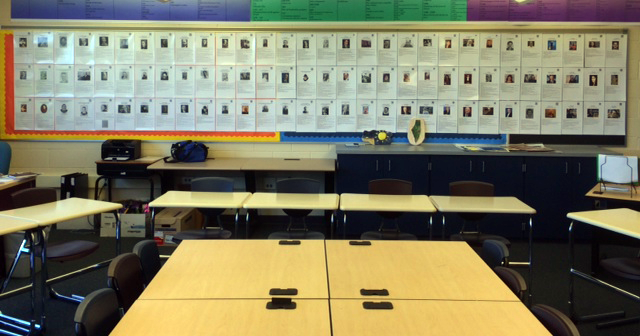Much like the Jews 3000 years ago, I have been a wandering Jew. Not from school to school, but from classroom to classroom. I never had a room of my own and therefore never had wall space to decorate or the ability to set the chairs the way that I wanted.
All of that changed this year. For the first time in more than 15 years of Jewish Day School teaching, I had my own classroom.
As a teacher of Jewish History, I was excited to create a classroom space that would come alive. Chairs we set in a semi circle to allow each student to see the others in class. The middle of the room has four large tables pushed together as a space for collaborative learning, projects and as a stage for our in-class dramatic performances (pushing the Azazel goat off the cliff involved students pushing students of the stage). Designing a meaningful wall space that will not only capture student attention but that can also be used as a teaching tool was the next goal. In order to achieve this goal, I used the resources of the JECC Teacher Center to create a thirty foot timeline which would incorporate the major dates that are part of my curriculum.
Then, using my curriculum and some outside help from the JEDLAB community, I created a list of over 200 influential Jewish personalities. The only requirement to make the list was that the person had to be Jewish (though in retrospect, through teaching the first half of the year, there are a number of non-Jewish personalities that positively impacted the Jews {Nicholas Winton and Charles Orde Wingate, as an example}). The list began with Abraham and continued to modern personalities such as Michael Levin, Mayim Bialik, Benjamin Netanyahu and David Blatt. The end goal in creating the list was to create a visual display (poster) of each personality to hang below the timeline. Little did I know that I would only have enough room (each poster is a legal size page) to hang personalities born in the 19th Century through today.


The next question was how to make the posters interactive. Guided by the staff at the JECC Teacher Resource Center, I learned the process of making tiny URLs using Google and how to create QR Codes (also using Google). The QR Codes and tiny URLs are linked to videos of each of the personalities.
Over the course of the first half of the year, students have gone on scavenger hunts looking for personalities born in certain places, those who made Aliyah, or those born in the same month as them. During down time, students gravitate towards the board. Allowing students to have their smartphones in class, they are encouraged to scan the code to learn more.
As a teacher, I use the wall daily to attach what we are learning to both a face and facts in order to help make a visual connection. I never realized how much of an aid the project could be to enhance my own teaching and learning.
Now I’m ready to take it to the next step. I have charged students with creating videos to link the few personalities for which finding a video proved difficult. Students have also been asked to create posters for personalities they feel are missing from “The Wall”, as we call it. In the future, the wall may come down – it may become our next text, a resource that can be taken home and shared with others. But whether hanging or on their desks, history has come alive.
Daniel can be reached at [email protected]










Leave a Comment